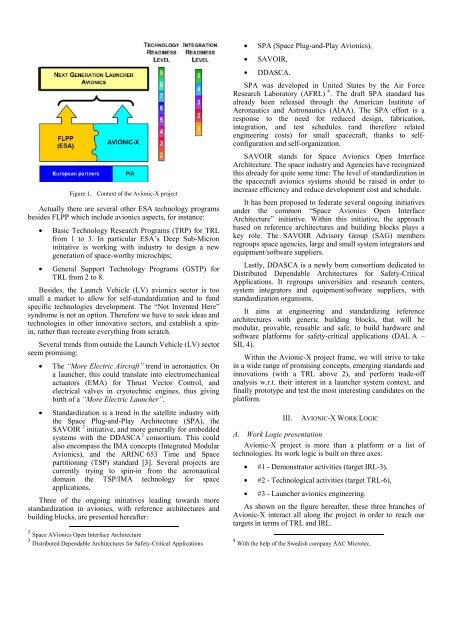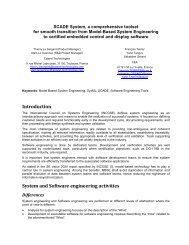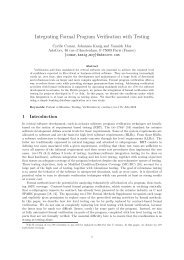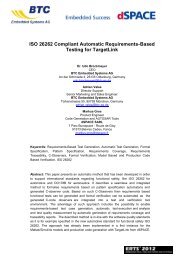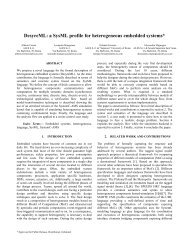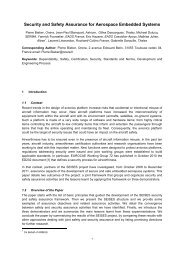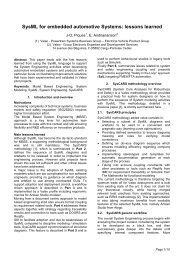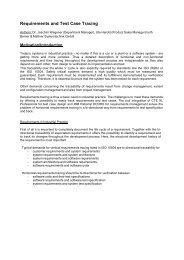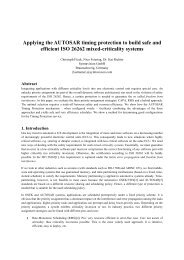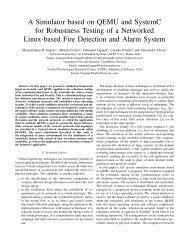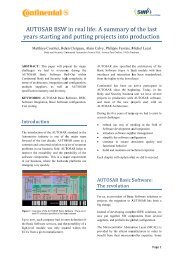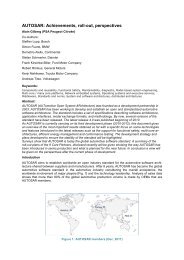Avionic-X: A demonstrator for the Next Generation Launcher Avionics
Avionic-X: A demonstrator for the Next Generation Launcher Avionics
Avionic-X: A demonstrator for the Next Generation Launcher Avionics
You also want an ePaper? Increase the reach of your titles
YUMPU automatically turns print PDFs into web optimized ePapers that Google loves.
3 Distributed Dependable Architectures <strong>for</strong> Safety-Critical Applications4 With <strong>the</strong> help of <strong>the</strong> Swedish company ÅAC Microtec.• SPA (Space Plug-and-Play <strong>Avionic</strong>s),• SAVOIR,• DDASCA.SPA was developed in United States by <strong>the</strong> Air ForceResearch Laboratory (AFRL) 4 . The draft SPA standard hasalready been released through <strong>the</strong> American Institute ofAeronautics and Astronautics (AIAA). The SPA ef<strong>for</strong>t is aresponse to <strong>the</strong> need <strong>for</strong> reduced design, fabrication,integration, and test schedules (and <strong>the</strong>re<strong>for</strong>e relatedengineering costs) <strong>for</strong> small spacecraft, thanks to selfconfigurationand self-organization.SAVOIR stands <strong>for</strong> Space <strong>Avionic</strong>s Open InterfaceArchitecture. The space industry and Agencies have recognizedthis already <strong>for</strong> quite some time: The level of standardization in<strong>the</strong> spacecraft avionics systems should be raised in order toFigure 1. Context of <strong>the</strong> <strong>Avionic</strong>-X projectincrease efficiency and reduce development cost and schedule.It has been proposed to federate several ongoing initiativesActually <strong>the</strong>re are several o<strong>the</strong>r ESA technology programs under <strong>the</strong> common “Space <strong>Avionic</strong>s Open Interfacebesides FLPP which include avionics aspects, <strong>for</strong> instance: Architecture” initiative. Within this initiative, <strong>the</strong> approach• Basic Technology Research Programs (TRP) <strong>for</strong> TRLbased on reference architectures and building blocks plays afrom 1 to 3. In particular ESA’s Deep Sub-Micronkey role. The SAVOIR Advisory Group (SAG) membersinitiative is working with industry to design a newregroups space agencies, large and small system integrators andgeneration of space-worthy microchips;equipment/software suppliers.Lastly, DDASCA is a newly born consortium dedicated to• General Support Technology Programs (GSTP) <strong>for</strong>TRL from 2 to 8.Distributed Dependable Architectures <strong>for</strong> Safety-CriticalApplications. It regroups universities and research centers,Besides, <strong>the</strong> Launch Vehicle (LV) avionics sector is toosmall a market to allow <strong>for</strong> self-standardization and to fundsystem integrators and equipment/software suppliers, withstandardization organisms.specific technologies development. The “Not Invented Here”syndrome is not an option. There<strong>for</strong>e we have to seek ideas andIt aims at engineering and standardizing referencetechnologies in o<strong>the</strong>r innovative sectors, and establish a spinin,ra<strong>the</strong>r than recreate everything from scratch.architectures with generic building blocks, that will bemodular, provable, reusable and safe, to build hardware andsoftware plat<strong>for</strong>ms <strong>for</strong> safety-critical applications (DAL A –Several trends from outside <strong>the</strong> Launch Vehicle (LV) sectorseem promising:SIL 4).Within <strong>the</strong> <strong>Avionic</strong>-X project frame, we will strive to take• The “More Electric Aircraft” trend in aeronautics. Ona launcher, this could translate into electromechanicalactuators (EMA) <strong>for</strong> Thrust Vector Control, andelectrical valves in cryotechnic engines, thus givingbirth of a “More Electric <strong>Launcher</strong>”.in a wide range of promising concepts, emerging standards andinnovations (with a TRL above 2), and per<strong>for</strong>m trade-offanalysis w.r.t. <strong>the</strong>ir interest in a launcher system context, andfinally prototype and test <strong>the</strong> most interesting candidates on <strong>the</strong>plat<strong>for</strong>m.• Standardization is a trend in <strong>the</strong> satellite industry with<strong>the</strong> Space Plug-and-Play Architecture (SPA), <strong>the</strong>III. AVIONIC-X WORK LOGICSAVOIR 2 initiative, and more generally <strong>for</strong> embeddedsystems with <strong>the</strong> DDASCA 3 consortium. This couldA. Work Logic presentationalso encompass <strong>the</strong> IMA concepts (Integrated Modular <strong>Avionic</strong>-X project is more than a plat<strong>for</strong>m or a list of<strong>Avionic</strong>s), and <strong>the</strong> ARINC 653 Time and Space technologies. Its work logic is built on three axes:partitioning (TSP) standard [3]. Several projects arecurrently trying to spin-in from <strong>the</strong> aeronautical• #1 - Demonstrator activities (target IRL-3),domain <strong>the</strong> TSP/IMA technology <strong>for</strong> space • #2 - Technological activities (target TRL-6),applications.• #3 - <strong>Launcher</strong> avionics engineering.Three of <strong>the</strong> ongoing initiatives leading towards morestandardization in avionics, with reference architectures and As shown on <strong>the</strong> figure hereafter, <strong>the</strong>se three branches ofbuilding blocks, are presented hereafter:<strong>Avionic</strong>-X interact all along <strong>the</strong> project in order to reach ourtargets in terms of TRL and IRL.2 Space AVionics Open Interface Architecture


